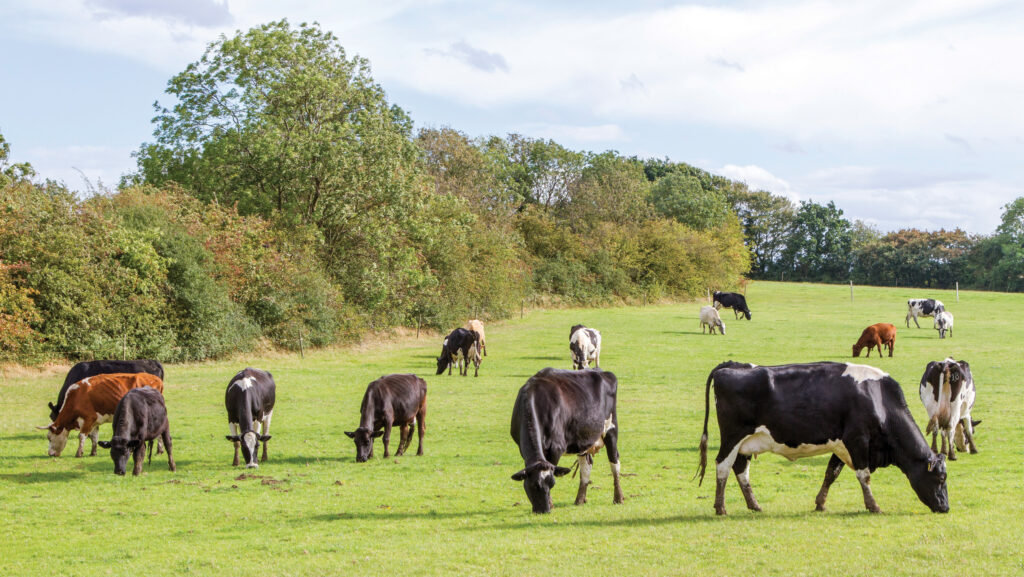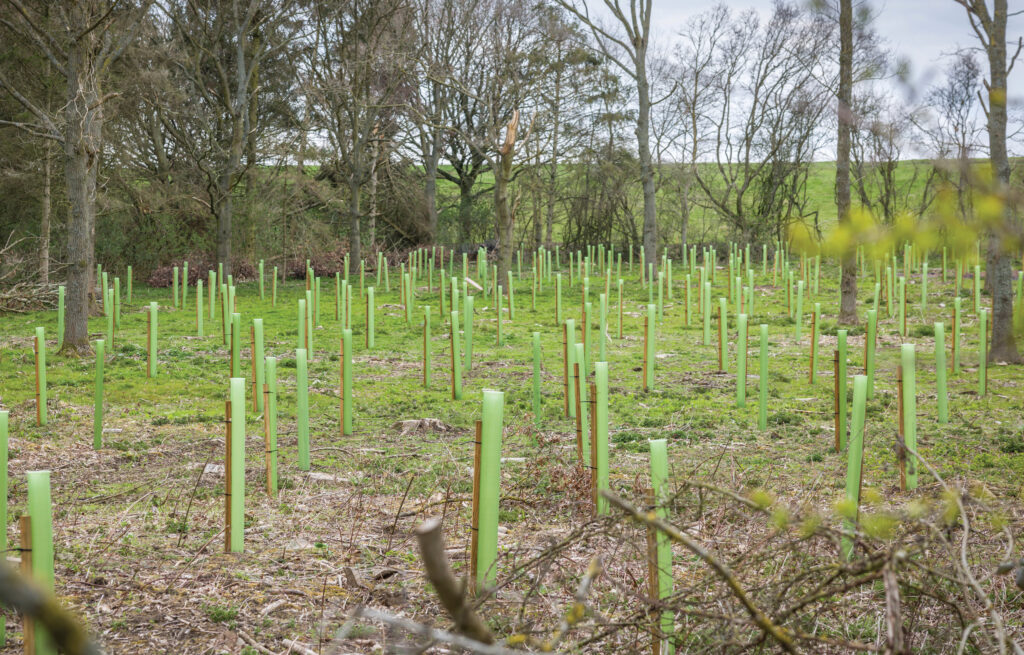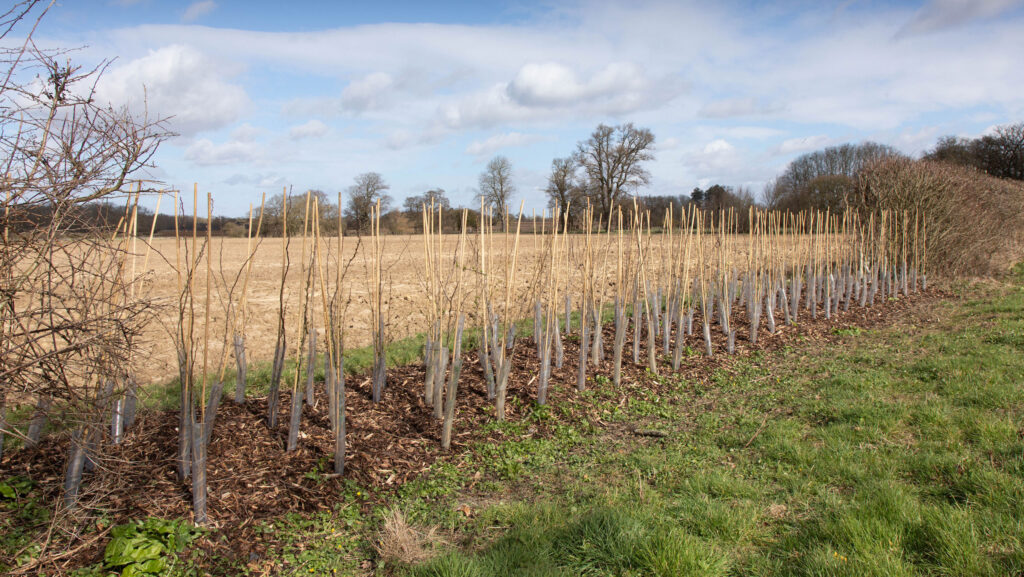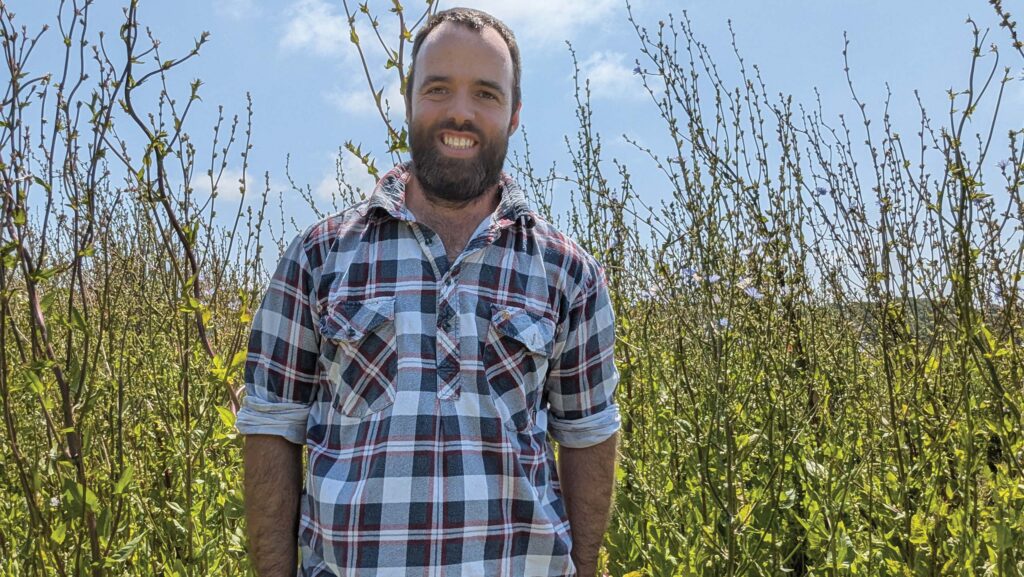Stacking income: What is it and how to do it on farm
 © GNP
© GNP Volatile prices and weather extremes have added risk and uncertainty to farm businesses while dwindling government support has caused a shortfall between pre- and post-Brexit incomes.
To make up that shortfall and spread risks, analysts and advisers are advocating a rethink of the traditional whole-farm management approach.
Instead, they suggest a hectare-by-hectare strategy focused on producing multiple income streams from land parcels – a process known as stacking.
See also: NFU Scotland pushes for capital grants funding rise
Stacking incomes can squeeze the most financial benefit out of a piece of land while the diversified streams help to spread the business risk.
This adds a layer of protection against market changes and the impact of extreme weather.
Here, four Transition partners – Agrovista consultant Lewis Butlin, AHDB senior economist Dr Amandeep Kaur Purewal, Agreena regen farming lead Thomas Gent, and Environment Bank principal land manager Rory Hodgson – explain how stacking can bolster incomes.
Stacking – rules and jargon
There are rules that govern what, and how many, public- and private-funded options can be stacked on a single piece of land.
From the outset it’s important to understand the key principles and jargon linked to the stacking process.
- What is stacking? Stacking refers to using a block of land to generate income from multiple streams such as production, environment schemes, grants, supply chain incentives, natural capital agreements and diversifications.
- Additionality To receive funding, farmers must demonstrate work undertaken for an environment or welfare scheme will result in a measurable, extra benefit. This is referred to as “additionality”.
- Double funding Double funding legislation is one of the biggest challenges in stacking payments for Transition work. The rules are in place to prevent farmers from getting paid by two schemes for the same environmental outcome or improvement.
How to start the stacking process
Stacking activities fit into three broad areas:
- Production
- Publicly funded schemes
- Privately funded ventures.
Production
“Headline figures for funding schemes can be attractive, but efficient production could still yield the highest income per hectare,” says Lewis.
He cites an example of a farm that adopted herbal leys across its entire pasture to maximise Sustainable Farming Incentive (SFI) payments.
Under the herbal ley, grass growth was reduced, silage yields fell and the farm had to buy in forage to achieve the herd’s milking potential.
It would have been more profitable to prioritise the grass growth on the most productive land and look to alternative options that could be stacked on other areas of the farm, he says.
“The example highlights that you must establish a detailed picture of the farm’s production potential before jumping into alternative incomes,” says Lewis.
AHDB analysis shows that the top 25% of farm businesses have a better grip on their costs and assets, says Amandeep.
There was no single thing they were doing but attention to detail was key.
So the first step in the stacking process is to review business data in as much detail as possible, she suggests.
The review should include financial and production performance figures and data on all assets.
This will help identify the most- and least-productive areas, which is crucial when looking at where stacking will yield the most benefit.
Once the output on each land parcel has been established, consider changes that could potentially improve soil health and yields, such as:
- New technology that improves efficiency
- Cover crops for soil health
- Rotation improvements to limit disease and boost soil health
- Intercropping or bicropping to help improve soil fertility, cut disease and add incomes
- Low-tillage options to improve organic matter and reduce input costs
- Better stock or plant genetics that improve production and meet added value markets.
Once the potential production system changes are identified, consider what funding measures could be stacked to help facilitate these.
Publicly funded schemes
England, Scotland, Wales and Northern Ireland offer government-backed incentives to improve the environment and farm business resilience.
For example, Scotland’s Preparing for Sustainable Farming (PSF) grant provides funding for soil sampling.
These not only provide some additional income but they improve efficiency and productivity, says Lewis.
Payments like this can be stacked on top of the agricultural output, he adds.
In England, the SFI scheme is the main government support.
Although it is currently suspended for applications, it is expected to reopen in 2026.
The following examples and analysis are based on the 2024 round and are a guide only to the principles of stacking payments.
“The SFI alone is not going to be enough to make up for the loss of EU support, but a carefully planned set of stacked options will help make up a significant amount of the shortfall,” says Lewis.
“It must be noted these payments come with additional management and groundwork costs to implement, particularly in the first year, which must be borne in mind,” adds Amandeep
Using farm models of grass-based and arable production, Amandeep’s analysis has found that an increase in profit was likely for both farm types, where SFI actions were implemented without sacrificing the most productive areas.
Livestock
- Stacked example SFI options for grassland production systems:
- CSAM1 Assess soil, produce a soil management plan and test soil organic matter
- CNUM1 Assess nutrient management and produce a review report
- CIPM1 Assess integrated pest management and produce a plan
- Boundary – CHRW1 Assess and record hedgerow condition (if entered, both sides will get double the payment rate – if have control/ownership)
- Boundary – CHRW2 Manage hedgerows condition (if entered, both sides will get double the payment rate – if have control/ownership)
- Boundary – CHRW3 Maintain or establish hedgerow trees (covers both sides of hedgerow, so just the payment rate as shown, £10/100m)
- PRF1 – Variable-rate application of nutrients
- PRF2 – Camera or remote sensor guided herbicide spraying
- CSAM3 – Herbal ley
Source: Amandeep Kaur Purewal/AHDB.
When applied to the model 150ha AHDB beef and sheep farm, similar options benefited incomes by up to £10,500/year over the three-year SFI agreement.
Arable
Stacked example options for arable production systems:
- CSAM1 Assess soil, produce a soil management plan and test soil organic matter
- CNUM1 Assess nutrient management and produce a review report
- CIPM1 Assess integrated pest management and produce a plan
- Boundary – CHRW1 Assess and record hedgerow condition (if entered, both sides will get double the payment rate – if have control/ownership)
- Boundary – CHRW2 Manage hedgerows condition (if entered, both sides will get double the payment rate – if have control/ownership)
- Boundary – CHRW3 Maintain or establish hedgerow trees (covers both sides of hedgerow, so just the payment rate as shown, £10/100m)
- SOH1 – No-till farming
- PRF1 – Variable-rate application of nutrients
- PRF2 – Camera or remote sensor guided herbicide spraying
- PRF4 – Mechanical robotic weeding
- SOH2 – Multispecies spring cover crop
- CIPM4 – No use of insecticide on arable or permanent crops
- CAHL2 – Winter bird food on arable and horticultural land
- AHW2 – Supplementary winter bird food (if there was a crop within this land parcel, for example, rapeseed, could also do CIPM3 – companion cropping)
Source: Amandeep Kaur Prewal/AHDB.
When the AHDB applied this level of stacking to a virtual 450ha arable farm, the model showed it received £18,400-£40,700 in additional income, depending on the level of options applied for.
With both livestock and arable models the more ambitious actions must be carefully balanced against production.
“The additional land taken up could affect grass or cash-crop yields and net profit levels are more likely to suffer if these actions are carried out on productive land,” points out Amandeep.
Grant schemes
Alongside the SFI, or regional equivalent, there are grants that could provide further stacked income as long as additionality rules are met.
Woodland Creation grants
Under the Nature for Climate Fund, the England Woodland Creation Offer (Ewco) pays out up to £10,200/ha, plus bonuses for projects that deliver wider benefits.
The goal is to provide public benefits, contribute to 2050 net-zero targets and create habitat for native flora and fauna.
There are four types of payment:
- Funding for 100% of standard capital costs to establish new woodland
- Annual maintenance costs for 15 years to protect the young trees
- A contribution towards installing infrastructure to enable management or recreational access
- Funding where the location allows additional public benefits including nature restoration, flood risk reduction, water quality improvements, riverside habitat improvements and recreational access.
Planting woodland not only attracts grants but also opens opportunities for stacking carbon credits or biodiversity net gain (BNG) units.

© Paul Maguire/iStockphoto
Despite the headline payments, the costs associated with the work required mean margins are quite tight.
“Again, consider the net return and ensure the options chosen fit with production aims,” advises Lewis.
Capital grants
Capital grants are available for projects such as hedgerow planting, water quality improvements and natural flood management, and are offered across the four UK regions. They include:
- Improving Farm Productivity
- Farming Equipment and Technology Fund
- Countryside Stewardship Capital Grants
- Future Farm Investment Scheme (Scotland)
- Small Grants – water or woodland (Wales)
- Farm Business Improvement Scheme (NI)
- Farmers Start-Up Grant (NI)
- Rural Business Development Grant (NI).
Innovate UK grants
The Farming Innovation Programme is a joint approach by Defra and Innovate UK to foster business-led research initiatives that help reduce farming’s environmental impact and find new ways of increasing productivity.
It does this through the Accelerating Development of Practices and Technologies (Adopt) scheme – farmer-led R&D projects that demonstrate the on-farm viability of technology and innovation.
Two grants are available – a facilitator grant, that funds expert support to make an application, and the project grant itself, worth up to £100,000.
Privately funded ventures
“Private funding for UK farming’s environmental efforts and natural assets is an income stream with huge potential,” says Rory.
“While private funding markets are still not a widely accessed source of finance on farms, they are gaining momentum as pressures on finances mount.”
There are now concrete examples of corporate investors willing to invest in agricultural works such as climate action and nature recovery, that help meet their company goals for sustainability, adds Thomas.
Among the best-known options are carbon credits, issued for sequestration and reduction in emissions and BNG units for wildlife habitat creation and restoration.
Carbon credits
A carbon credit is a tradable financial unit that represents the removal of 1t of carbon dioxide from the atmosphere or the equivalent reduction in emissions.
Carbon credits are an additional payment that reward sustainable farming efforts.
“It is possible to stack carbon credits with certain environmental scheme options and BNG unit trading,” says Thomas.
For example, you could be paid for BNG units by a developer and for carbon credits by a corporation with a net-zero strategy for separate contracts on the same land.
“Carbon credits work alongside regenerative farming practices,” adds Thomas.
“The first step is to review the farm’s management data for the previous five years.
“From that information, we can carry out a carbon audit and establish a baseline to gauge the improvements in carbon from the new practices adapted in subsequent years,” he says.
Practices include regenerative farming practices such as low-till, wider rotations and cover crop use.
Agreena will carry out the data verification process for the new approach and annual auditing of sustainable farming methods.
The farmer has a requirement to submit new data post-harvest for the previous 12 months each year.
Agreena then calculates the number of carbon credits and issues those credits to the market.
Values can vary, but the normal range that a farmer can earn per hectare is between £20 and £50.
Once issued, the credits belong to the farm business, says Thomas.
There has been some reticence on entering the carbon market.
“However, there is no commitment to trade credits on the carbon market straight away.
“Instead, they can be stored up over years if desired,” Thomas explains.
Delaying the process of issuing credits just means the farm is missing out on years of potential rewards for sustainable work, he adds.
When ready to sell, Agreena will take the credits to market and find buyers
BNG
The BNG scheme is underpinned by UK environmental policy that requires construction developments to have a measurably positive impact on biodiversity.
The units quantify the value of habitats, such as hedgerows, and watercourses.

© Tim Scrivener
Environment Bank creates and sells BNG units to developers, allowing them to meet the mandatory government requirements.
“The first step is for farmers to register the details of their land with Environment Bank,” says Rory.
A team of ecologists will then identify suitable habitat areas and management options that will integrate with the existing farming use.
Environment Bank enters an agreement to lease land and its staff work with farmers to create or improve existing habitats.
This generates thriving plant and wildlife populations that can be measured and converted into BNG units, which developers can purchase to offset habitat loss from their projects.
Lease agreements are for a minimum 30-year period, providing landowners with guaranteed rent and management payments that can be stacked with other income streams.
Habitat banks can be sited on poorer land so that the more productive areas can continue to be farmed.
Certain agricultural use is allowable on the area designated for BNG unit production and habitat banks fit well with sustainable livestock farming, Rory points out.
For example, grazing and hay cutting are encouraged to stimulate plant growth, build organic matter and enhance biodiversity following grazing, he says.
It means as well as the BNG unit income it’s possible to stack revenue from lamb, beef or hay.
BNG can also incorporate woodland areas as part of the habitat creation and enhancement.
The landowner receives rent and management payments for the woodland but can also benefit from the timber, fruit or nut crops, adding further income potential, says Rory.
You may be able to utilise BNG and the Ewco on the same land, but there are constraints.
Renewable energy
Land may also be leased to renewable energy companies such as Lightsource BP, which works with farmers and landowners on solar packages. Leases of more than 30 years are offered.
Rental incomes are paid from the outset of construction work and index-linked, rising annually in line with inflation.
The solar panels and equipment typically occupy only 40% of the leased land, and the design of the arrays offers stacking possibilities with livestock production.
Landscape Enterprise Networks (Lens)
Other areas where funding can be secured are through Landscape Enterprise Networks (Lens).
Private companies invest directly in projects that enhance their operations or supply chains, building resilience to climate change.
Like the Adopt scheme, Lens brings together private organisations and farmers to collaborate on environmental change and supply chain resilience.
It first identifies the organisations, such as food suppliers and utility companies, with a need and an ability to fund environmental good practice.
It then engages farmers that can provide the natural assets to meet those needs.
Finally, Lens negotiates transactions between the farmer and the company to fund the work.
Supply chain schemes
Supply chain incentives offered by processors or buyers are also emerging as valuable stackable income streams.
One such scheme is Arla’s FarmAhead programme, a point-based system that rewards specified environmentally sustainable activities.
Up to 3 eurocents/litre can be earned per farm.
Points are distributed across 19 option areas, allowing farmers to find ones that suit their particular regimes and environmental targets.
Further points are added for attending knowledge exchange events throughout the year.
Case study: Dave Oates

© Dave Oates
Cornish farmer Dave Oates believes farms need to stack enterprises and offer more than food alone to remain financially and environmentally sustainable.
Dave is a Nature Friendly Farming Network ambassador, and he and his brother Stuart are the seventh generation of the Oates family to manage Rosuick Farm on the Lizard peninsula.
Key to preserving Rosuick for future generations is the philosophy that farming should use the land to provide goods and services that benefit both society and the natural environment.
Multi-level system
Also a Nuffield scholar studying the potential of stacking, Dave has refined farming practice at Rosuick into a system that works on multiple levels.
Broadly, at the base level, the system is an extension of traditional farming with organic production of beef and sheep and mixed arable rotations including diverse cropping, he explains.
The next level is building soil fertility and increasing carbon stocks, which could have a financial gain.
Permanent pasture used to be the least profitable areas under the Basic Payment Scheme, says Dave.
But now, some grassland is under the Sustainable Farming Incentive (SFI) herbal ley option, while others are in species-rich grassland options.
Hay crops are taken from these areas and wildflower seed is harvested using a machine developed by Dave and Stuart.
The seed is then sown under contract on local farms with biodiversity net gain sites adding another income stream.
For the arable enterprise, there is a focus on carbon, with some of the farm baselined after soil sampling.
The carbon data is held for insetting to trade within the farm’s supply chain rather than sold as credits.
Wild bird seed plots
Mixes of wild bird seed plots, grown under Countryside Stewardship, have been tweaked to include varieties that add positively to the soil microbiome, boosting plant health and growth.
The palatable mix provides a further opportunity, with cattle brought in to graze once the seeds have been taken off.
The forage source can provide weeks of additional feed for the beef herd.
Finally, the aftermath acts as a green manure ahead of the incoming crop.
Agroforestry is then stacked on top of this. The agroforestry venture is set to expand, with 40ha planted in the past few years, says Dave.
Natural blocks of willow have added silvoculture opportunities, providing shade and shelter for grazing animals and, in turn, improving growth rates and yields.
Other fields have different tree species either for fruit or timber.
Woodland
The woodland enterprise is funded by Forest for Cornwall, which paid for all of the establishment.
An aim is to secure SFI payments for maintenance as the trees mature.
Hedgerows can provide further income through SFI management options and planting trees that can yield further, timber, fruit and nut crops.
Improving hedgerows is an important venture because they yield an additional income from previously unproductive areas.
They also provide soil fertility and wildlife habitat, says Dave.
Improving the wildlife habitats makes the farm more attractive to visitors and research bodies and that has created further income streams.
One such example is a Farm Innovation Project.
The projects allow the farm to cover costs for some crops but, importantly, give detailed data to inform decision-making, says Dave.
Almost 60 school visits also take place at the farm each year along with farm walks for farmers, research organisations and environmental groups.
All of the school visits are funded via Countryside Stewardship agreements, while the farm walks are paid for at an hourly rate.
Events like weddings are hosted on the wild bird seed plots adding another income stream.
